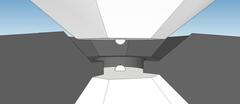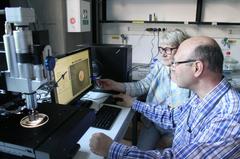URL: https://www.desy.de/news/news_search/index_eng.html
Breadcrumb Navigation
DESY News: Record high pressure squeezes secrets out of osmium
News
News from the DESY research centre
Record high pressure squeezes secrets out of osmium
An international team of scientists led by the University of Bayreuth and with participation of DESY has created the highest static pressure ever achieved in a lab: Using a special high pressure device, the researchers investigated the behaviour of the metal osmium at pressures of up to 770 Gigapascals (GPa) – more than twice the pressure in the inner core of the Earth, and about 130 Gigapascals higher than the previous world record set by members of the same team. Surprisingly, osmium does not change its crystal structure even at the highest pressures, but the core electrons of the atoms come so close to each other that they can interact – contrary to what is usually known in chemistry. This fundamental result published in the journal Nature has important implications for understanding physics and chemistry of highly compressed matter, for design of materials to be used at extreme conditions, and for modelling the interiors of giant planets and stars.

A schematic of the pressure chamber of the double-stage diamond anvil cell: The osmium sample is just 3 microns small and sits between two semi-balls made of nanocristalline diamond of extraordinary strength. Credit: Elena Bykova/University of Bayreuth
“High pressure is known to radically affect properties of chemical elements: metals like sodium may become transparent insulators; gases like oxygen solidify and become electrical conductors – and even superconductors,” explains Natalia Dubrovinskaia from the University of Bayreuth, together with Leonid Dubrovinsky the main author of the study. “As any other material subjected to very high compression, osmium is expected to change its crystal structure.”

For probing the samples under these extreme conditions, the team used high-brilliance X-rays from the synchrotron sources PETRA III at DESY, ESRF in France and APS in the U.S. The team found that Osmium shows unprecedented structural stability and keeps its crystal structure even at huge pressures of about 770 GPa.

Prof. Dr. Natalia Dubrovinskaia and Prof. Dr. Leonid Dubrovinsky working on a micro manipulator used to prepare the samples for the double staged diamond anvil cell. Credit: University of Bayreuth
The experiments pave the way for investigating materials under conditions of the inner core of giant planets. “In the last 20 years, astronomers found more than thousand planets around other stars, nearly all of them bigger than our Earth,” says co-author Hanns-Peter Liermann from DESY, responsible for the beamline P02 at PETRA III, where some of the experiments took place. “With the newly developed double-stage diamond anvil cell and with the very focused high intensity X-ray spot at PETRA III – or later at the X-ray laser European XFEL that is currently being constructed in the Hamburg area – we can probe a variety of rocky planet compositions under most extreme conditions and will learn a lot about the composition and evolution of such planets.”
Reference:
The most incompressible metal osmium at static pressures above 750 GPa;L. Dubrovinsky, N. Dubrovinskaia, E. Bykova, M. Bykov, V. Prakapenka, C. Prescher, K. Glazyrin, H.-P. Liermann, M. Hanfland, M. Ekholm, Q. Feng, L. V. Pourovskii, M. I. Katsnelson, J. M. Wills, and I. A. Abrikosov; Nature (2015); DOI: 10.1038/nature14681



